You have no items in your cart. Want to get some nice things?
Go shoppingCourtesy of Riot Material Magazine
“I have pushed for the transformation of Manifesta…into a more inclusive, pragmatic and sustainable format that turns signals into substance.” – Hedwig Fijen, founding director of Manifesta
Buzz words fly around at the press conference launching Manifesta 12 in the breathtaking Renaissance Church of Santa Caterina: incubator, civic cooperation, testing ground, sustainability, interconnection, flowing networks. The 12th edition of the biennial took as guiding vision the “Planetary Garden,” a term coined by French gardening philosopher Gilles Clément. They add that Manifesta, the nomadic biennial, was created in the early 90s as a response to the erection of new partitions and borders in Europe after they had been felled in the previous decade. Manifesta 12 wants to shift perspectives, in order to imagine and promote caring for the world through collaboration, the second tier of its title, “Cultivating Coexistence”. This “cultivating,” a gardening of sorts, is to replace the existing paradigm of one species’ domination at all cost. The concept of cultivation is to be applied to the city of Palermo itself, with the ambition of bringing lasting change and empowering its citizens of all origins and classes.
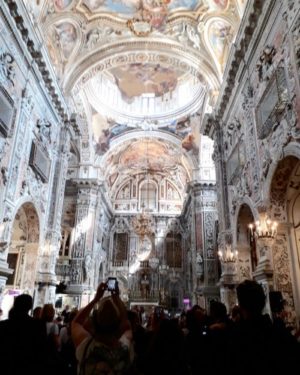
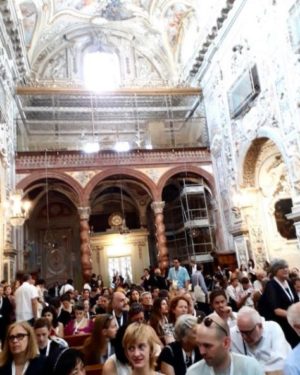
An abandoned building, the Garibaldi Theater, has undergone a most dashing renovation that will become one of the legacies of Manifesta to Palermo. It works as the main hub where accreditations are processed, panels and interventions held, and the space is notable for a modesty often lacking in the art world. No huge banners signal its facade, nor are we assailed with the usual branding and signage mania. The space is continuously open from auditorium through the servicing desks to the street. The only toilet lacks a lock, so visitors guard each other’s privacy in an atmosphere of casual goodwill. International filmmakers Laura Poitras and Henrik Moltke, legendary for documenting the excesses of US surveillance, try to make themselves heard above the general din. They are introducing the results of their residence at the Italian National Film School. The school’s documentary branch happens to be located in Palermo, enabling Poitras and Moltke to mentor the film students that were invited to produce films for Manifesta 12. The excitement is palpable as clips are projected in the presence of the young filmmakers. The films, surprisingly assured and expressive for student work, address sociopolitical issues such as the refugees’ conditions of life. The audience cringes as a paternalist evangelical proselytizes a young African. Regurgating submissively the minister’s every word, the refugee seems to crave the attention, and potential clout, of someone outside his limited social circle.
Another film, as well as of a number of pieces at the Biennial, deals with the subject of MUOS. The global communication system (Mobile User Objective System) has been implemented by the US Navy in four locations around the world to facilitate military communications and support war from a distance. With Europe, Africa and the Middle East all within reach of drones and unmanned planes, Sicily was an obvious strategic choice For this documentary, young African refugees who know the area inside out, and are skilled at avoiding patrols, guided the filmmakers through the devastated wilderness surrounding the compound. Crawling right up to the tall fences, the team shot an unmanned plane taking off to an unidentified destination, for an unidentified purpose. Breathtaking. And an inspiring example of collaboration across differences for the common good.
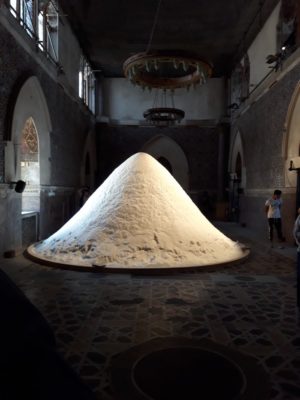
While the press conference and the initial panels serve as invitation to critical thinking, a performance at the Palazzo Forcella de Seta dips into a very different register. The dilapidated palace, reopened for the Biennial, shows influences from the Middle East, Africa and Europe in its elaborate ceramic tiles and ceiling decorations. In a sumptuous room, a mountain of salt induces the visitors to circle around its commanding appearance, complete with landslides and shiny facets. Salt, a universal commodity for humans, is extracted from the sea where countless refugees have lost their lives. This substance also refers to the belief held by enslaved Africans that if they ate no salt they would be able to fly back to Africa. Black artist Patricia Kaersenhout, the creator of The Soul of Salt, calls to the forefront a group of shy young refugees. They sing an adaptation of a 19th century American slave song. As they get more confident from hearing each other’s voices, and from the emotion projected by the audience, their song rises above the scintillating salt to fill the room: “No more drowning at sea, No more, no more. No more private property, No more, no more.” Next, a black man from the ex-Dutch colony Suriname in South America blesses the salt through a sacred ritual including prayers and singing. Described as “a spiritual leader” in the program, and a likely descendant of slaves himself, he spreads a few pinches around the room, then spits a liquid from a bottle, which turns out to be rum, on the heap. Finally, the artist invites the visitors to carry back some of the salt and dissolve this symbol of suffering in water to complete the cycle of commemoration.
Nearby, as the sun sets on the stunning gulf of Palermo, people gather at the Foro Italico Park, right next to the sea. A European woman dabs green paint on a young African man’s face, both dressed in green. In fact, the whole group is wearing green, with every skin surface in the process of getting painted too. Once all the participants are transformed, the color of their skins cannot be told apart. Age and gender, too, become irrelevant. A man picks up a large carved statue, and other participants lift more figurines or baskets carrying plants. The happening makes for a striking effect, the altered human figure bringing to mind diverse branches of mythology, while the mood is both solemn and joyous amongst the participants. As the procession moves toward the center of the city, it gathers more and more followers. Local gawkers from a working class neighborhood whisper: “What is happening? What is this? “This” is a reinvention, commissioned by Manifesta, of the famous procession of Santa Rosalia, the patron saint of the city, which takes place every summer. This version, entitled Festino della Terra (The Earth’s Banquet), has been conceived by Jelili Atiku, from Nigeria, and inspired by Yoruba customs and the myth of the Green Man. The locals approve, mouthing “multicultural.” They profess to have no problems with the influx of immigrants to Sicily. “These people were hungry in their country,” says a man pinching a comfortable paunch. “Many Sicilians had to emigrate too,” adds an elderly woman with stunning blue eyes. They know very little about Manifesta, and don’t seem too interested. Meanwhile the procession reaches the center busy with tourists and shoppers, its leader blessing various landmarks along the way with a final ceremony at the Palazzo Costantino, another abandoned palace.
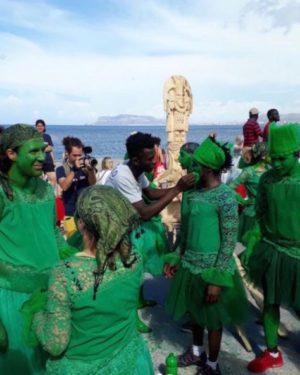
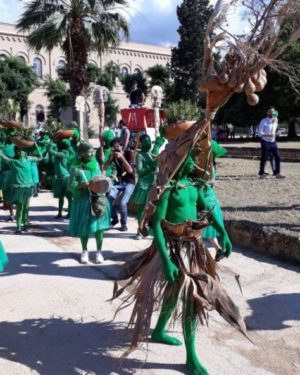
The young migrants from the procession are most willing to share their story: “I’ve been here three years. I come from Gambia.” “My name is Pape. I’m from Senegal, I’ve been here two years.” “I didn’t know anybody here. I came by myself. When I was hungry, people didn’t know, they gave me water or a cigarette. Because hunger doesn’t show.” “I’m waiting for my documents to move North. There is little work here, al nero, and it pays badly.” “The worst is the waiting. Nothing to do. Listening to the same old stories.” “I don’t regret coming over, the trip, the dangers. Here I have a future. I’m going to Italian language school.” “I don’t know much about Manifesta, about art. I’m interested in music, in movies, in theater. Is theater art? An American guy, his family was from Sicily, he did theater with us. I liked it, but we weren’t paid. After a week, he returned to his country, and we went back to waiting.” “The people at Manifesta said we would be paid for taking part in the procession. Not a lot, but paid. I hope it’s true.”

Another procession in the antique tradition of Sicily is presented the next day by Italian artist Marinella Senatore. It could easily be mistaken for a regular religious celebration. Every marching band, association, cheerleader, every school dance program, every choir from Palermo seems to be involved in this joyous cacophony. But various choreographies devised by Maria Fonzino gather retired Italians, African migrants, and working class women from the ZEN housing project. The banners also resemble those meticulously produced by parishioners and brandished in religious processions, but their messages, in Sicilian dialect, and sometimes English, speak to a different ideology: “Knowledge is power,” “Nomadic and polyvocal.” A line from a famous anonymous poem from Sicily encourages resistance: “You complain, but what do you do with your complaint? Take a stick and beat their teeth out!” The whole procession concludes with a vibrant protest song, Senatore, fist in the air, leading the way as the Palermo people stomp down the narrow streets behind her.
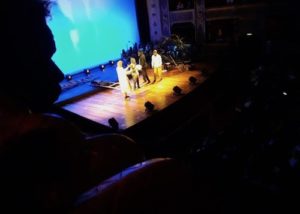
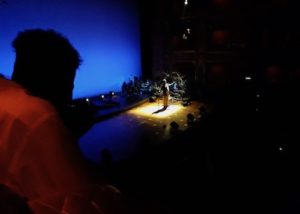
For a couple of nights, A Sahel Opera, by composer Bintu Were, is performed at the Teatro Massimo, a colossal theater from the 19th century all gold and red velvet magnificence. The main singers are mature African migrants, while the chorus is composed of recently arrived young Africans, all trained by a music school for the purpose of the festival. It tells the story of young farmers from West Africa seduced into migrating, including a pregnant woman. In the very desirable first row of the gallery, young African migrants watch the show. They are enthralled, their fascination intensifying as the story, so close to their own, follows its course on stage. During changes of scenery, their eyes wander over the lavishness of the venue, an environment as distant as can be from the impoverished African countryside most of them come from. On stage, the drama reaches its tragic climax. The pregnant migrant dies trying to climb the last fence to Mellila, and her fellow villagers decide to go back to their home. Carrying portable lights, they form a moving procession through the audience made up mostly of the local bourgeoisie, just as African refugees mingle with the local population on the streets. While the show does not always exhibit the artistic standards they are used to, the audience is sensitive to the emotional charge, to the achievement accomplished. They respond all the more enthusiastically when their charismatic Mayor, Leoluca Orlando, stands up in his grand central lodge. Young members of the chorus wave triumphantly to their friends who applaud them from the gallery. As they exit through the lobby, hugs meld performers and junior members of the crew, mostly Italians. Just as in any performing company, they delight in the elation and bonding that come from working hard toward a goal, and seeing it come to life.
Manifesta 12 not only delivers on its pledge to involve locals of various origins, and refugees in particular, but succeeds in cultivating the coexistence of residents and outsiders, bourgeois and migrants, art connoisseurs and lay people. It can only be imagined what single-mindedness has been required, hard work, meticulous thinking-through, flights of the imagination and heart,and a pinch of egotism for good measure. The performances that celebrate the opening of the Biennial feel like ancient, authentic rituals because of the perfect coincidence of themes, locations and actors. The views on the Mediterranean lapping the shore gently outside the windows of the Palazzo de Seta while the salt of tears gets blessed indoors [my photo:Aiutamicristo visitor window], the Baroque richness of the Nigerian procession against the extravagant architecture of the buildings dotting its route, the 19th century Teatro Massimo, the utter symbol of the ruling bourgeoisie in Europe, opening its doors to young refugees, affect deeply the visitors with their powerful contrasts and dynamics. Poignancy, brilliant social critique, spirituality make for a Biennial defiantly different from the contemporary art world and its exclusive functions.
Part 2 : Manifesta 12 Promises The World. And Delivers

About Arabella Hutter von Arx
Arabella Hutter is a writer with a particular interest in women issues and the arts. She writes articles about art and literature for magazines, pieces about New York City for European newspapers, and her fiction is represented by Lotus Lane Literary. She has a background as a film and television writer/producer whose work includes films and documentaries for the British Film Institute, the BBC, and Channel 4, in addition to several international independent and experimental films. She collaborated on 14 episodes of "Inside the Actors' Studio" for Bravo with Glenn Close, Jessica Parker, Holly Hunter, Gene Wilder, and more. She was the Executive Director of The International Quorum of Motion Picture Producers from 2012 to 2015. Raised in Switzerland, based in Brooklyn, she travels the world on a regular basis with a preference for India, Thailand, Turkey, and Italy.
- Web |
- More Posts(3)




